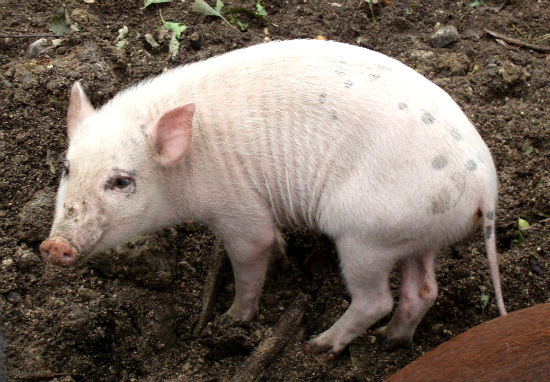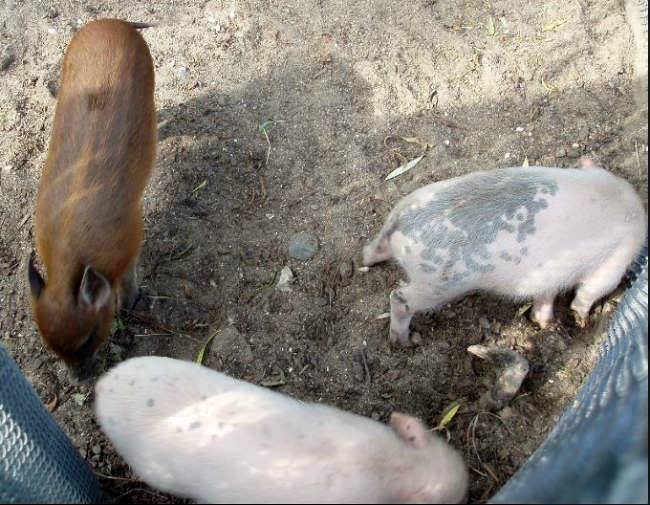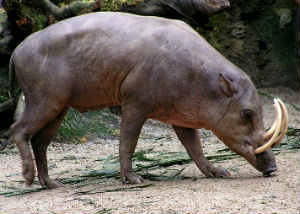Babirusa-pig Hybrids
Mammalian Hybrids
EUGENE M. MCCARTHY, PHD GENETICS, ΦΒΚ
|
Things you don’t expect happen more often than things you do.
—Plautus, Mostellaria
|
In 2006 at the Copenhagen Zoo, a babirusa boar mated with a domestic sow, which later gave birth to five hybrid piglets of both sexes. The chief zoologist at the zoo, Bengt Holst, said this cross “is about as likely as a cross between a billy goat and a cow” and rated it a “zoological world sensation.” Indeed, the two differ greatly in morphology. For example, the stomach of a babirusa presents striking similarities to that of a relatively simple ruminant such as the domestic sheep (see image below), while the domestic pig’s is much like that of a human being (image below).
|
Pig stomach (Sus scrofa)
|
The zookeepers had put two sows with the babirusa boar after his mate died. “We weren’t worried about the erotic activity that resulted,” said Holst “since nothing could possibly come of it.”
Article continues below
 One of the Copenhagen Zoo babirusa-pig hybrids. This individual is still a piglet.
One of the Copenhagen Zoo babirusa-pig hybrids. This individual is still a piglet. The hybrids born at Copenhagen Zoo were quite variable in appearance even though they were all produced from an F1 cross.
The hybrids born at Copenhagen Zoo were quite variable in appearance even though they were all produced from an F1 cross.
Chromosome analysis of one of the surviving males has confirmed it was indeed a hybrid between domestic pig and a babirusa. There was a complete haploid set of 19 porcine chromosomes, as well as a complete haploid set of 19 babirusa chromosomes in the karyotype.
|
Sus scrofa |
One reason this cross is of interest is that it is one of those that constitute a counterexample to the old idea, dating back to at least the time of Aristotle, that organisms must have gestation periods of the same length if they are to produce hybrids. The domestic pig has a gestation period of 115 days, whereas that of the babirusa averages 153 (150-157 days), a difference of 33 percent. It is also a good example of the sort of bias that exists with regard to hybrid crosses, that is, how people often make up their minds that a cross cannot work, even when there is no experimental data touching on the issue, and even when they are biologists.
|
|
None of the surviving piglets, two males and one female, showed signs of sexual maturity by the age 27 months. Histological examination of gonadal biopsies from the males revealed both were azoospermatic. Immunostaining revealed SCP3-positive axial elements in the nuclei of primary spermatocytes, indicating that they were progressing through leptotene and pachytene of meiotic prophase. However, the presence of multiple short stretches of axial elements in pachytene nuclei indicated that this phase was blocked, probably due to aberrant chromosome pairing. Histological examination of the ovaries revealed follicular structures, but oocytes within them were generally degenerated. Thomsen et al. 2011. state that the infertility of the hybrids was “most likely due to germ cell death resulting from abnormalities of chromosome pairing during meiotic prophase." Note that the report states that oocytes in the female were only "generally degenerated,” which seems to suggest that some ova were not. If such is the case, then it is possible that females from this cross will prove fertile in backcrosses, as is the case in many other types of mammalian hybrids.
Sus scrofa has been introduced into the Indonesian range of B. babyrussa, so natural hybridization may also occur.
By the same author: Handbook of Avian Hybrids of the World, Oxford University Press (2006).
Reference: Thomsen et al. 2011. Internet report: Der Standard (August 18, 2006). Pictures 1, Pictures 2.
